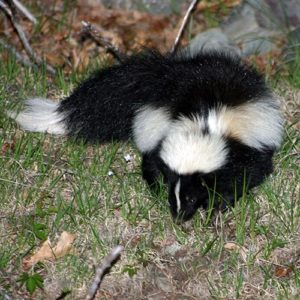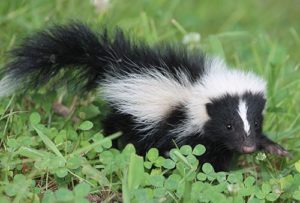Overview
Skunks may not be the first animal that pops into your mind for backyard wildlife, but they are common visitors to many yards. Because they are active at dusk and during the night, they often go unobserved. Despite their infamous defense mechanism, they don’t have a very strong smell unless they’ve been provoked.
The striped skunk (Mephitis mephitis) is our most common species of skunk and can be found throughout most of the U.S. and into parts of Canada and Mexico. This is also the species that is most often portrayed in cartoons and photographs. Skunks are members of the mustelid family, along with weasels, mink, and otters.

What do they look like?
If you remember Flower from Bambi or Pepe Le Pew from Bugs Bunny, then you have a pretty good idea of what a striped skunk looks like. They are roughly the size of a house cat with males being slightly bigger than females. Striped skunks are typically black with white on the top of the head, two white stripes running over the back and some degree of white on the tail. However, the exact amount of white on any individual striped skunk can vary quite a bit. On our farm, I’ve seen everything from only a small white patch on the top of the head to individuals that look like they have more white fur than black fur.
Where do they live?
In the wild, striped skunks are most often found near the edges of woods and fields. They will either dig a den or take over an abandoned den that was dug by a coyote, woodchuck, or fox. Skunks have even been known to den up in a shallow cave or under a brush pile. They are very adaptable and have also taken to urban and suburban life where they can be found living under porches, in open crawl spaces, in culverts, and in similar locations.
What do striped skunks eat?
Skunks are omnivores and eat a wide variety of foods. Insect grubs are some of their favorite foods and they will dig up a grub infested yard as they pursue one of their favorite foods. However, their efforts to rid a yard of pesky grubs is rarely appreciated by those who like perfectly manicured lawns. Beekeepers also know that skunks can be hive predators and will stand at the front of the hive eating bees as they come out and trying to get at the brood located inside the hive.
In addition to different types of insects, skunks will also eat fruit, berries, and the eggs of ground nesting birds. When a skunk finds an egg, it will bite off the end of the egg and eat the contents, leaving the rest of the shell intact, making it easy to identify skunk nest predation. Around homes and human dwellings, skunks will also eat petfood left outside, birdseed that has fallen to the ground under a bird feeder, and garbage that wasn’t placed in a container they couldn’t get into.
Their life history
Skunks are most active at dawn, dusk, and during the night. They typically live by themselves, unless it is a female with that year’s young. Female striped skunks go into heat in February and the males become much more active at that time as they search for receptive females. Males roaming around looking for females is why the scent of skunk along the roads becomes so much more common in the late winter and early spring. It’s the same reason why so many deer are hit in the late fall during rut.
Female striped skunks will only breed once each year, but male striped skunks will breed with multiple females. The female is the sole caregiver for her young. Young striped skunks are typically born in May or June, and are called kits or kittens. The average litter size is around 5 kits. When the kits are born, their eyes are closed and they remain in the den with the mother. The young striped skunks are weaned after about one and a half to two months. They will then follow their mother outside at night to learn how to forage before setting out on their own, usually sometime in August or September.
In the winter, several skunks may share the same den, presumably for warmth. There have even been reports of other animals such as rabbits and woodchucks being found in different “rooms” of a larger den used by skunks during the winter. Skunks don’t hibernate, but instead will go into short states of deep sleep called torpor during the coldest days of the winter. On warm winter nights, striped skunks will be active and out looking for food.
What are the main predators of striped skunks?

Although coyotes and bobcats will occasionally prey on skunks, they tend to leave skunks alone. The same is true for most of our mammalian predators. The most common predator of skunks is the great-horned owl. In some areas, eagles are also a common predator of striped skunks. Most birds don’t have a good sense of smell, which makes the skunk’s primary defense weapon useless against owls and other birds of prey.
The striped skunk’s defense mechanism
The infamous smell of skunks is produced by two scent glands near the base of the tail. The scent glands are attached to two nipples that the skunk can use to aim its spray. A skunk can accurately project its spray 10-15 feet on a calm day. The spray is an oily musk that can be very hard to neutralize. It is so good at carrying odors, that it has been used as a base for some high-end perfumes. In addition to the chemicals that cause the rancid odor, the spray contains sulfuric acid and can cause temporary blindness if it gets in an animal’s eyes.
Even with the effectiveness of its spray at detouring perceived threats, skunks will only spray as a last resort. A skunk will often go through an elaborate display of stamping its feet, raising its tail, and hunching its back to try to scare off the would-be attacker. However, if that doesn’t work and the skunk bends so both its head and raised tail are pointed in the same direction, then watch out!
Avoiding conflicts around your home
In the eastern U.S., striped skunks can be found in both urban and rural areas. For the most part, they aren’t anything to worry about and most conflicts can be easily avoided. Striped skunks don’t see very well, so pay attention if you are out at dusk, dawn, or during the night. Sometimes you may smell a nearby skunk before you see it, but it is amazing how little scent they have if they haven’t sprayed in a while. I’ve almost walked up on them before because of that, so don’t rely only on your sense of smell.
Softly talking or gently clapping your hands can let them know you are there and give them a chance to retreat without getting spooked or immediately going into defense mode. Turning on an outside light and taking a second to look before letting your dog out at night is another good way to help prevent potential unpleasant surprises. Other easy ways to prevent potential conflicts is to not leave pet food sitting outside at night, to not let spilled birdseed build up under feeders, and to make sure your garbage is stored in a tightly closed container.
Summary
Striped skunks are common visitors to rural, suburban, and urban yards across much of the country. Despite their infamous defense system, they are cute and fun to watch. However, like all wild animals, they need to be respected and will defend themselves if they feel threatened.

Backyard Ecology: Exploring Nature in Your Backyard
Nature isn’t just “out there.” It’s all around us, including right outside our doors. Hi, my name is Shannon Trimboli, and I am the host of Backyard Ecology. I live in southcentral Kentucky and am a wildlife biologist, educator, author, beekeeper, and owner of a nursery specializing in plants for pollinators and wildlife conservation. I invite you to join me as we ignite our curiosity and natural wonder, explore our yards and communities, and improve our local pollinator and wildlife habitat. Learn more or subscribe to my email list at www.backyardecology.net.

Leave a Reply